Manual cleaning of surgical instruments is widely used in health care facilities, even though this system leaves residues in a high percentage of cases.
In hospital settings it is essential that medical instruments are spotless. Any failure during the cleaning process of the instruments, especially if they are to be used in high-risk areas, may represent a danger for the patient. Poor manual washing of surgical instruments could allow microorganisms to multiply and cause feverish reactions or delayed recovery or healing after surgery.
Removing every trace of organisms from medical instruments is vital in order not to endanger the health of the patients on whom they will be used. Being able to guarantee a clean residue-free work implies that manual cleaning should only be performed when it is the only possible option.
To sum up, manual cleaning does not guarantee the proper sanitization of instruments.
Pablo Castiglione, Head of Technical Service and Projects Area at Fibonacci Argentina, assures that “being able to standardize a process and make it independent from the person that performs it ensures that all the processes have the same standard.”
What is Verify Resi-test and what value does it provide?
It is a cleaning indicator that is used after manual or automatic cleaning to determine whether an instrument is clean. It is easy to interpret since it produces an easy-to-see color change and only takes around 5 seconds to show the result.
Its use helps to spot potentially dangerous particles or microorganisms on previously washed instruments and to prevent future risks for the patient. This verification method, besides delivering accurate information about the instrument’s sanitization status, provides safety when taking it to be sterilized for reuse.
The importance of ultrasonic cleaning should also be acknowledged, and it should be considered as a technological solution for the cleaning of medical equipment that shows significant advantages compared to manual washing.
Changing the paradigm of manual cleaning:
In most of Argentina’s health care institutions cleaning is performed manually and it is difficult to admit that the procedure is poorly executed since the instruments are not left in optimal conditions for use.
One of the main barriers encountered in the local health care industry is that beyond the sterilization procedure, the use of drugs is advancing to avoid potential risks to patients.
In this sense, Castiglione points out that every process needs standardization: “When we compare manual cleaning vs. automatic cleaning, we know that if we put ‘x’ instruments in the automatic washer in a certain position, we can be sure that regardless of the cycles and the number of times they are washed, the water will clean them in the same way, the same time, with the same temperature, the same amount of water, etc.”.
It is important to focus on this point, since with the use of thermal disinfectors the risks are minimized and the cleaning of the instruments is optimized.
“Every process needs standardization. When we compare manual cleaning vs. automatic cleaning, the latter will always be the same, regardless the cycles.”





